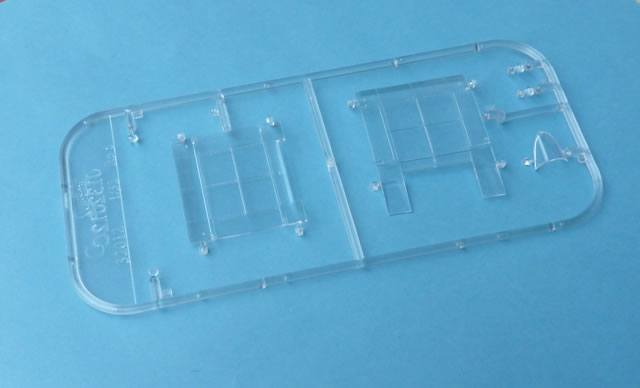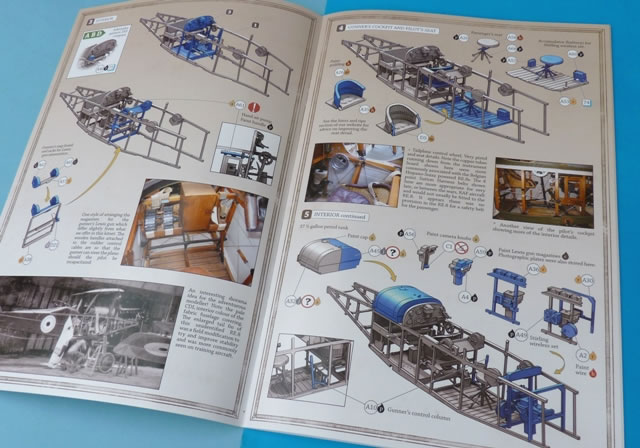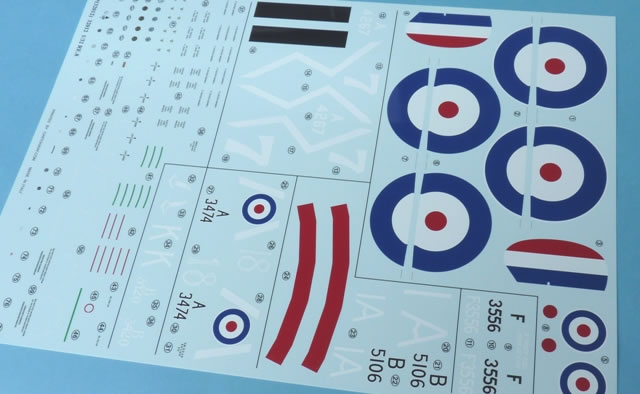RE.8 "Harry Tate"

Wingnut Wings, 1/32 scale
S u m m a r y |
Catalogue Number: |
Wingnut Wings 32012 - RE.8 "Harry Tate" |
Scale: |
1/32 |
Contents and Media: |
10 sprues of plastic (9 coloured and 1 clear), a fret of photo etched parts and a decal sheet containing markings for 5 aircraft. |
Price: |
USD$89.00 - available online from Wingnut Wings.
Includes free international postage. |
Review Type: |
First Look |
Advantages: |
Cleverly engineered for ease of assembly, outstanding representation of the surface detail, crisp clean mouldings, comprehensive decal sheet in perfect register with minimal carrier film, photo-etched seat belts and a mini “Datafile” for an instruction booklet. |
Disadvantages: |
|
Conclusion: |
British two-seaters get another run from Wingnut Wings and this is certainly one of their best. Despite the complexity of the original, this kit captures the “look” of the RE8 perfectly and does so with some clever engineering that makes assembly a breeze. Detail is not compromised and the level of commitment is clear to all when one sees the portrayal of wrinkled fabric on the fuselage halves. It’s an amazing package that allows the modeller to build a quality 1:32 scale example of this iconic aircraft for their collection. |
Reviewed by Rob Baumgartner

HyperScale is proudly supported by Squadron
The RE8 is not a pretty looking aircraft...but it is a favourite nonetheless.
It was the eighth design in the “Reconnaissance Experimental” series and was intended to replace the aging BE series of two-seaters. A major difference between the two types was the seating positions. The “Harry Tate” had the pilot at the front of the aircraft with the observer enjoying a much improved view from the rear of the machine.
Armament was another welcome addition. Now the crew would have another means of defending themselves while carrying out their duties.
Ironically the aircraft still carried over many features of its predecessor. The geometry of the wings was essentially the same as the BE2e, these now being of RAF 14 section. A similarity can also be seen in the tailplane and elevators. These only contained detail changes to allow for the RE8’s method of incidence regulation.
It served as an artillery spotter, reconnaissance aircraft, and even a bomber if the occasion presented itself. Over 4000 examples were delivered to the RFC/RAF before the end of the war and as such it saw service in many theatres.
Wingnut Wings has pulled out all the stops on this one. Inside the large sturdy box are 10 sprues of plastic (9 coloured and 1 clear), a fret of photo etched parts and a decal sheet containing markings for 5 aircraft. Each item is individually wrapped to ensure that no harm will come of them when rattling around during transit.
The quality of the moulding is first-class with sharp detail and no sink marks whatsoever. The plastic is not of the brittle type seen in other manufacturers’ products and this makes it more forgiving during the cleanup and assembly process.
The entire interior structure is made up as a separate entity and this is trapped between the fuselage halves. Nearly 50 parts contribute to the crew positions. There is a lot to see inside these openings and every effort has been made to include as much detail as possible.
The usual suspects are here, such as the seats (stool for the observer), choice of instrument panel layout, oil and petrol tanks, control columns, rudder bar and tailplane adjustment wheel.
Photo-etched lap belts are included and to better help with the “sit”, it is recommended that these be annealed. This material is also used to detail the scarf ring, machine guns and “leather” control cable exit holes.

Other essentials found in the respective “offices” are Morse transmitter keys, RL (Royal Laboratories) bomb/flare tube, Very pistol, and grease pump for the Vickers gun synchronizing gear. Added to these are a camera, Stirling wireless set (with battery packs), antenna reel, gunner’s map board, and a bevy of ammunition drums, all of which help this area to look very busy indeed.
To add a bit of extra finesse, one can add the structural bracing and internal control wires. The instructions give an indication of where these should go although their exact placement will require further investigation.
The RAF 4a engine is a lovely kit in itself. Despite the apparent complexity, each of the 37 parts falls into place easily. The detail is exquisite and the rendition of the cylinder cooling fins is a perfect example of what’s on offer.
Everything fits comfortably between the nicely rendered fuselage halves. These exhibit a hint of fabric wrinkling, a feature first seen on the WNW SE5a. It was typical of these airframes and kudos to them for replicating it here.
The wings on the RE8 are huge. To make sure there is sufficient strength, the lower ones have been moulded in one piece. This means that the dihedral is built in and it fits securely into the assembled fuselage.
The upper item is in three pieces as per the original. The large tabs of the outer wings slot positively into the centre section thus ensuring a strong join at the correct angle. This middle portion consists of 2 types and both can be found inside the box. One is moulded in clear plastic and represents the often over-painted triplex glass, the other being fabric covered.

All of the flying surfaces have sharp trailing edges and present a subtle representation of the stitching showing through the rib tapes.
To help animate your subject, we get separate ailerons, elevators and rudder.
Speaking of options, the kit also caters for both early and late undercarriage legs. The former were made of steel and was surrounded by a wooden fairing whereas the later type consisted of wood only. There is also a choice of cowlings and the different types of armament are not forgotten.
As well as the associated bomb carriers, the modeller has various explosive devices at their disposal. A selection of 20lb Cooper bombs and 100-112lb Hale bombs are provided. The latter option comes in early or late styles, the difference being in the shape of the fins.
The bane of most WWI modellers is making sure that the wings and undercarriage line up properly with the fuselage. One of the hallmarks of these kits is the positive location points of the struts. This release is no exception with a dry fit revealing that all should be well with this part of the assembly.
As with previous offerings, we get an instruction book that also doubles as reference material. During the building process, the pages are frequently punctuated with close-up photographs of RE8s to help the modeller add those extra pieces of detail should they so desire.

The booklet also includes a comprehensive rigging diagram which leaves little to the imagination when applying this finishing touch.
Marking Options
The generous decal caters for five options, all of which are all contained on a single sheet of A4 decal paper.
All items were printed in perfect register and are surrounded by a minimum of carrier film. They are quite thin and the colour density is excellent, all things that we expect from Cartograf. Decal setting solutions can be used safely but it is wise to stay away from the stronger solutions.

Apart from the usual roundels, unit and individual markings, there is also a wealth of other data included. This relates to stencilling (including bits and pieces for the ordinance), instrument faces, logos, and even a map for the clipboard.
- RE8 serial A3474 “18”, Siddeley-Deasy built, 34 Sqn, 2lt CCF Osborn &Sgt J Lewis, May 1918.
After being brought down by anti-aircraft fire on 24 May 1917, this aircraft was given a thorough going over by German photographers. Both pilot and observer survived the encounter and were made prisoners of war.
- RE8 serial A4267 “7”, Austin built, 52 Sqn, March 1918.
This aircraft first saw service with 9 Sqn before transferring to 52 Sqn. It is depicted here in the latter’s zigzag marking down the top and sides of its fuselage. Photos indicate a possible repair on the top wing which appears glossier than the rest of its surroundings.
- RE8 serial B3420 “K”, Daimler built, 3 Sqn AFC.
An interesting subject is this Australian crewed aircraft from 3 Sqn AFC. Featuring a white kangaroo and boomerang, it also carries Holt landing lights on the bottom wings.
- RE8 serial B5106 “1A”, Daimler built, 59 Sqn.
Adding some colour to this aircraft are the two red bands used by 59 Sqn until March of 1918. Once again we see the Holt landing lights fitted to the lower wings but in this case another light has been added to the rear fuselage.
- RE8 serial F3556 “Ceylon No. 1 – A Paddy Bird from Ceylon”, Daimler built, October 1918.
Now an exhibit in England’s Imperial War Museum, this aircraft was the second to wear the inscription “A Paddy Bird from Ceylon”. It did not see wartime service due to its late arrival in France.
It is easy to run out of superlatives for these kits. The professionalism directed towards the product is evident as soon as one views the packaging.
Everything is included to allow for a very relaxing build straight out of the box. But if you wish to add more detail for an even more impressive replica, this journey should also be a pleasurable one thanks to the way the kit is engineered. The mindset used by the manufacturer is towards ease of assembly and this is evident throughout. Detail has not been compromised as a result, nor has accuracy.
The package represents excellent value for money and at the time of writing still comes with free worldwide shipping. What better time is there to add this worthy addition to your collection of Allied World War One aircraft?
Review Text and Images Copyright © 2010 by Rob Baumgartner
Page Created 31 January, 2011
Last updated
31 January, 2011
Back to HyperScale Main Page

|
